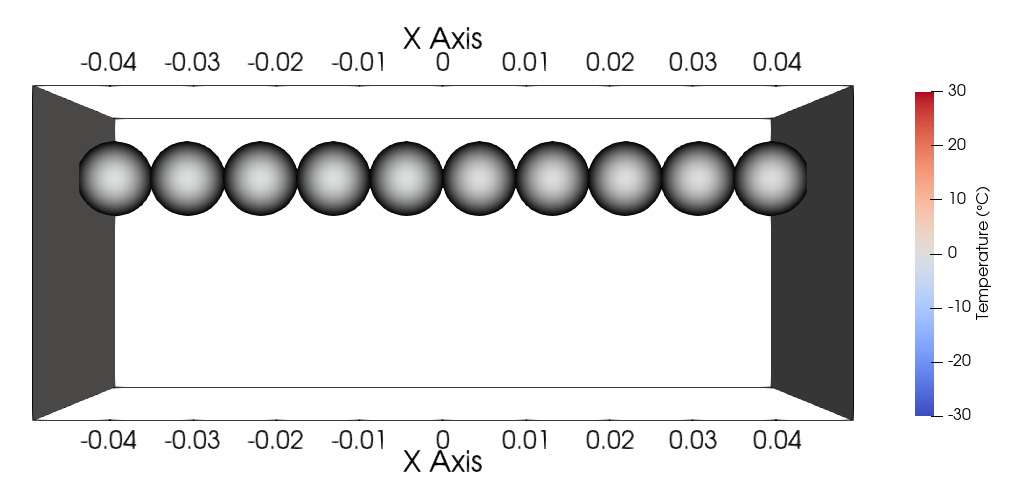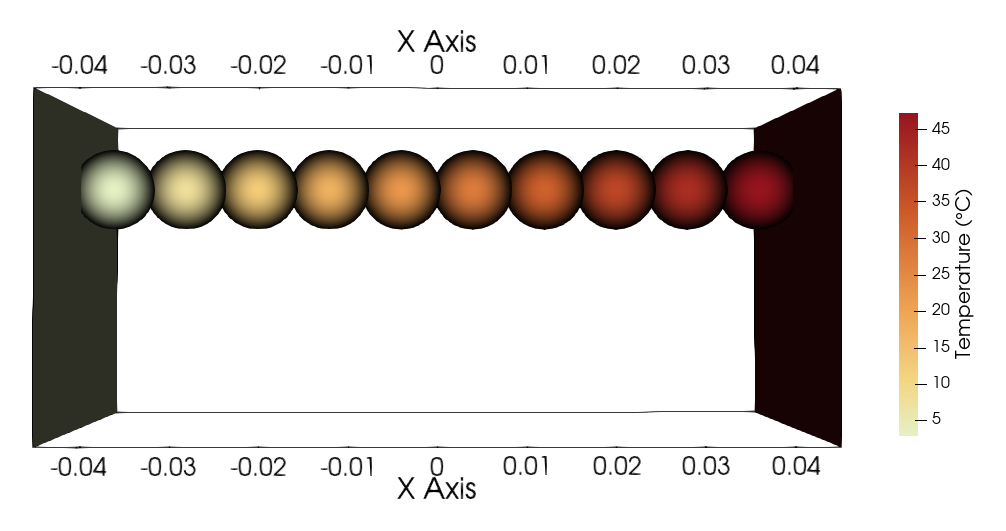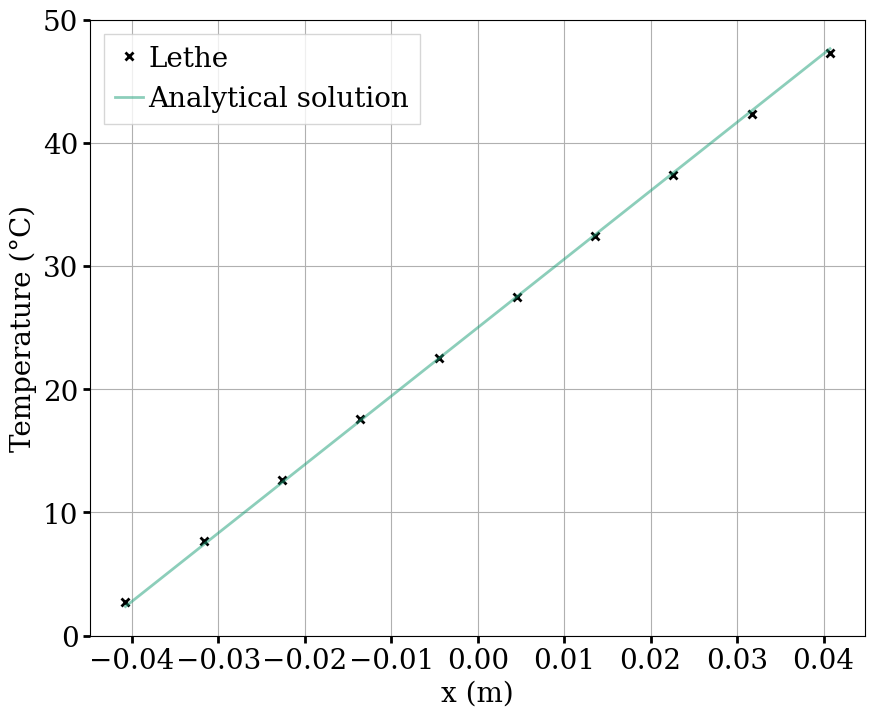Heat Transfer in Aligned Particles#
This example introduces the use of multiphysic DEM with a simple example that consists of lined up particles that are heated by others or by a wall. It verifies the models of particle-particle and particle-wall heat transfer using two simple test cases.
Features#
Solvers:
lethe-particlesMultiphysic DEM
Three-dimensional problem
Moving solid surfaces
Heating solid surface
Post-processing using Python, PyVista, lethe_pyvista_tools, and ParaView.
Files Used in This Example#
All files mentioned below are located in the example’s folder (examples/dem-mp/3d-heat-transfer-in-aligned-particles).
Parameter files:
equilibrium.prm,wall-heating.prmGeometry files solid surfaces:
square-left.geo,square-right.geoInput files:
particles-equilibrium.input,particles-wall-heating.inputPost-processing Python scripts:
equilibrium-postprocessing.py,wall-heating-postprocessing.py
Description of the Cases#
In the first stage of both simulations, 10 particles are put in contact. The solid surfaces on the left and right move towards the center to compress the particles, until they are all in contact on a line.
In the case of the equilibrium simulation, particles on the left side have a temperature of \(-30°C\) and particles on the right side have a temperature of \(30°C\). When all the particles are in contact on a line, the mean temperatures of the particles on the left and the particles on the right should vary towards the whole mean temperature, i.e. \(0°C\) here.

Temperatures at the start of the equilibrium simulation#
In the case of the wall-heating simulation, all particles start with a temperature of \(0°C\). The walls also have a temperature of \(0°C\). When all the particles are in contact on a line (\(t=8 s\)), the temperature of the right wall is set to \(50°C\). After some time, the temperature of the particles should be a linear function of their position.

Temperatures at the start of the wall-heating simulation#
Parameter File#
Mesh#
The domain we simulate is a rectangular box with dimensions \(0.30\times0.05\times0.5\) meters and is made using the deal.ii grid generator.
subsection mesh
set type = dealii
set grid type = hyper_rectangle
set grid arguments = -0.15 , -0.025 , -0.025 : 0.15 , 0.025 , 0.025 : false
set initial refinement = 1
end
Lagrangian Physical Properties#
The \(10\) particles are mono-dispersed, with a diameter of \(10\) mm.
Some parameters used in multiphysic DEM, like the thermal conductivity and specific heat, were chosen to ensure the simulations are fast enough, as simulations involving temperature can take up a lot of time to reach a steady state. Since these test cases are focused on temperature, and particles are set on a horizontal line, gravity is not taken into account.
subsection lagrangian physical properties
set g = 0.0, 0.0, 0.0
set number of particle types = 1
subsection particle type 0
set size distribution type = uniform
set diameter = 0.01
set number of particles = 10
set density particles = 2500
set young modulus particles = 1e6
set poisson ratio particles = 0.3
set restitution coefficient particles = 0.3
set friction coefficient particles = 0.3
set rolling friction particles = 0.3
set thermal conductivity particles = 3000
set specific heat particles = 300
set microhardness particles = 1.e9
set surface slope particles = 0.1
set surface roughness particles = 1.e-9
set thermal accommodation particles = 0.7
end
set young modulus wall = 1e6
set poisson ratio wall = 0.3
set restitution coefficient wall = 0.3
set friction coefficient wall = 0.3
set rolling friction wall = 0.3
set thermal conductivity gas = 0.2
set specific heat gas = 10000
set dynamic viscosity gas = 9.e-6
set specific heats ratio gas = 1.4
set molecular mean free path gas = 68.e-9
end
Model Parameters#
subsection model parameters
subsection contact detection
set contact detection method = dynamic
set dynamic contact search size coefficient = 0.9
set neighborhood threshold = 1.3
end
set particle particle contact force method = hertz_mindlin_limit_overlap
set rolling resistance torque method = constant
set particle wall contact force method = nonlinear
set integration method = velocity_verlet
set solver type = dem_mp
end
Particle Insertion#
Since the simulations only involve \(10\) particles, they were inserted at precise locations using the file insertion method and input files particles-wall-heating.input for the wall-heating simulation and particles-equilibrium.input for the equilibrium simulation.
subsection insertion info
set insertion method = file
set insertion frequency = 10000
set list of input files = particles-wall-heating.input
end
subsection insertion info
set insertion method = file
set insertion frequency = 10000
set list of input files = particles-equilibrium.input
end
Solid Objects#
For the equilibrium simulation, walls are considered adiabatic and move towards the center until they reach their set location.
subsection solid objects
subsection solid surfaces
set number of solids = 2
subsection solid object 0
subsection mesh
set type = gmsh
set file name = square-left.msh
set simplex = true
set initial refinement = 0
end
subsection translational velocity
set Function expression = if(x<-0.049,0.01,0) ; 0 ; 0
end
subsection angular velocity
set Function expression = 0 ; 0 ; 0
end
set center of rotation = -0.11 , 0 , 0
set thermal boundary type = adiabatic
end
subsection solid object 1
subsection mesh
set type = gmsh
set file name = square-right.msh
set simplex = true
set initial refinement = 0
end
subsection translational velocity
set Function expression = if(x>0.049,-0.01,0) ; 0 ; 0
end
subsection angular velocity
set Function expression = 0 ; 0 ; 0
end
set center of rotation = 0.11 , 0 , 0
set thermal boundary type = adiabatic
end
end
end
For the wall-heating simulation, walls have a uniform temperature (isothermal) and move towards the center until they reach their set location.
subsection solid objects
subsection solid surfaces
set number of solids = 2
subsection solid object 0
subsection mesh
set type = gmsh
set file name = square-left.msh
set simplex = true
set initial refinement = 0
end
subsection translational velocity
set Function expression = if(x<-0.045,0.01,0) ; 0 ; 0
end
subsection angular velocity
set Function expression = 0 ; 0 ; 0
end
set center of rotation = -0.11 , 0 , 0
set thermal boundary type = isothermal
subsection temperature
set Function expression = 0
end
end
subsection solid object 1
subsection mesh
set type = gmsh
set file name = square-right.msh
set simplex = true
set initial refinement = 0
end
subsection translational velocity
set Function expression = if(x>0.045,-0.01,0) ; 0 ; 0
end
subsection angular velocity
set Function expression = 0 ; 0 ; 0
end
set center of rotation = 0.11 , 0 , 0
set thermal boundary type = isothermal
subsection temperature
set Function expression = if(t>8,50,0)
end
end
end
end
Simulation Control#
The simulations run for 20 and 15 seconds of real time, respectively. We output the simulation results every 10000 iterations.
subsection simulation control
set time step = 5e-5
set time end = 20
set log frequency = 10000
set output frequency = 10000
set output path = ./output_equilibrium/
set output boundaries = true
end
subsection simulation control
set time step = 5e-5
set time end = 15
set log frequency = 10000
set output frequency = 10000
set output path = ./output_wall_heating/
set output boundaries = true
end
Running the Simulation#
The simulations can be launched with
Note
Parallel calculations are not necessary here as there are only \(10\) particles.
Post-processing#
A Python post-processing code is provided for each case: equilibrium-postprocessing.py and wall-heating-postprocessing.py.
The first post-processing script is used to check that the two mean temperatures (of particles with \(x<0\) and \(x>0\)) do get close to the global mean temperature at the end of the equilibrium simulation.
The second script is used to confirm that the temperature of the particles matches the analytical solution \(T(x) = Ax+B\), where \(A\) and \(B\) are found using the temperature and position that are set for the left and right walls.
It is possible to run the post-processing codes with the following commands. The argument is the folder which contains the .prm file.
Important
You need to ensure that lethe_pyvista_tools is working on your machine. Click here for details.
Results#
Results for the Equilibrium Simulation#
The simulation can be visualised using Paraview as seen below.

Temperatures at the end of the simulation#
The following figure shows that the two mean temperatures do converge towards \(0°C\), as expected.

It was noticed while choosing the parameters for the simulation that the more the walls compress the particles, the faster the mean temperatures reach \(0°C\). This highlights the importance of the overlap in the particle-particle and particle-wall heat transfer models.
Results for the Wall-heating Simulation#
The simulation can be visualised using Paraview as seen below.

Temperatures at the end of the simulation#
The following figure compares the temperatures of the particles at the end of the simulation with the analytical solution \(T(x) = Ax+B\).

The results show very good agreement with the analytical solution.